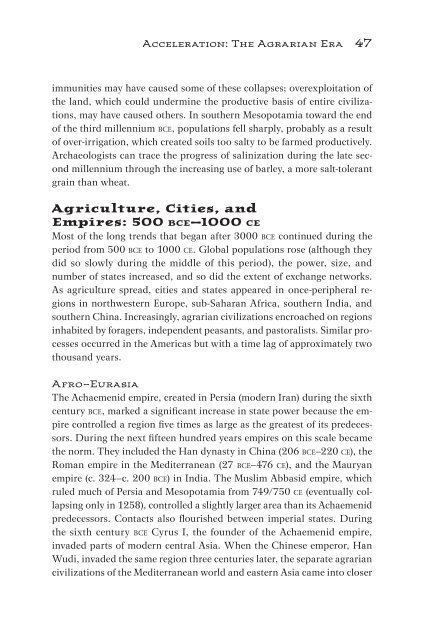This Fleeting World
This Fleeting World
This Fleeting World
Create successful ePaper yourself
Turn your PDF publications into a flip-book with our unique Google optimized e-Paper software.
Acceleration: The Agrarian Era 47<br />
immunities may have caused some of these collapses; overexploitation of<br />
the land, which could undermine the productive basis of entire civilizations,<br />
may have caused others. In southern Mesopotamia toward the end<br />
of the third millennium bce, populations fell sharply, probably as a result<br />
of over-irrigation, which created soils too salty to be farmed productively.<br />
Archaeologists can trace the progress of salinization during the late second<br />
millennium through the increasing use of barley, a more salt-tolerant<br />
grain than wheat.<br />
Agriculture, Cities, and<br />
Empires: 500 bce–1000 ce<br />
Most of the long trends that began after 3000 bce continued during the<br />
period from 500 bce to 1000 ce. Global populations rose (although they<br />
did so slowly during the middle of this period), the power, size, and<br />
number of states increased, and so did the extent of exchange networks.<br />
As agriculture spread, cities and states appeared in once-peripheral regions<br />
in northwestern Europe, sub-Saharan Africa, southern India, and<br />
southern China. Increasingly, agrarian civilizations encroached on regions<br />
inhabited by foragers, independent peasants, and pastoralists. Similar processes<br />
occurred in the Americas but with a time lag of approximately two<br />
thousand years.<br />
Afro-Eurasia<br />
The Achaemenid empire, created in Persia (modern Iran) during the sixth<br />
century bce, marked a significant increase in state power because the empire<br />
controlled a region five times as large as the greatest of its predecessors.<br />
During the next fifteen hundred years empires on this scale became<br />
the norm. They included the Han dynasty in China (206 bce–220 ce), the<br />
Roman empire in the Mediterranean (27 bce–476 ce), and the Mauryan<br />
empire (c. 324–c. 200 bce) in India. The Muslim Abbasid empire, which<br />
ruled much of Persia and Mesopotamia from 749/750 ce (eventually collapsing<br />
only in 1258), controlled a slightly larger area than its Achaemenid<br />
predecessors. Contacts also flourished between imperial states. During<br />
the sixth century bce Cyrus I, the founder of the Achaemenid empire,<br />
invaded parts of modern central Asia. When the Chinese emperor, Han<br />
Wudi, invaded the same region three centuries later, the separate agrarian<br />
civilizations of the Mediterranean world and eastern Asia came into closer


